Abstract
We have determined the structure and organization of the entire Qa family of class I genes from the major histocompatibility complex of the C3H mouse. Restriction maps of overlapping lambda and cosmid clones reveal that there are only five Qak genes: Q1k, Q2k, Q4k, Q10k and a Q5/9 hybrid, presumably generated by unequal homologous recombination. The resulting deletion of Q6-Q9 is consistent with the Qa-2null phenotype of this mouse strain. We have sequenced the Qak genes, and predict that each may encode a class I molecule with a structure comparable with that proposed for the transplantation antigens. Furthermore, these Qa products should be able to bind peptides and interact with appropriate T-cell receptors. Interestingly, in comparing Qak and H-2k sequences, we find limited evidence of interlocus gene conversion between Qa and H-2 loci, suggesting that the Qa genes are not likely to serve as a reservoir of genetic information for the generation of H-2 diversity within this haplotype.
Full text
PDF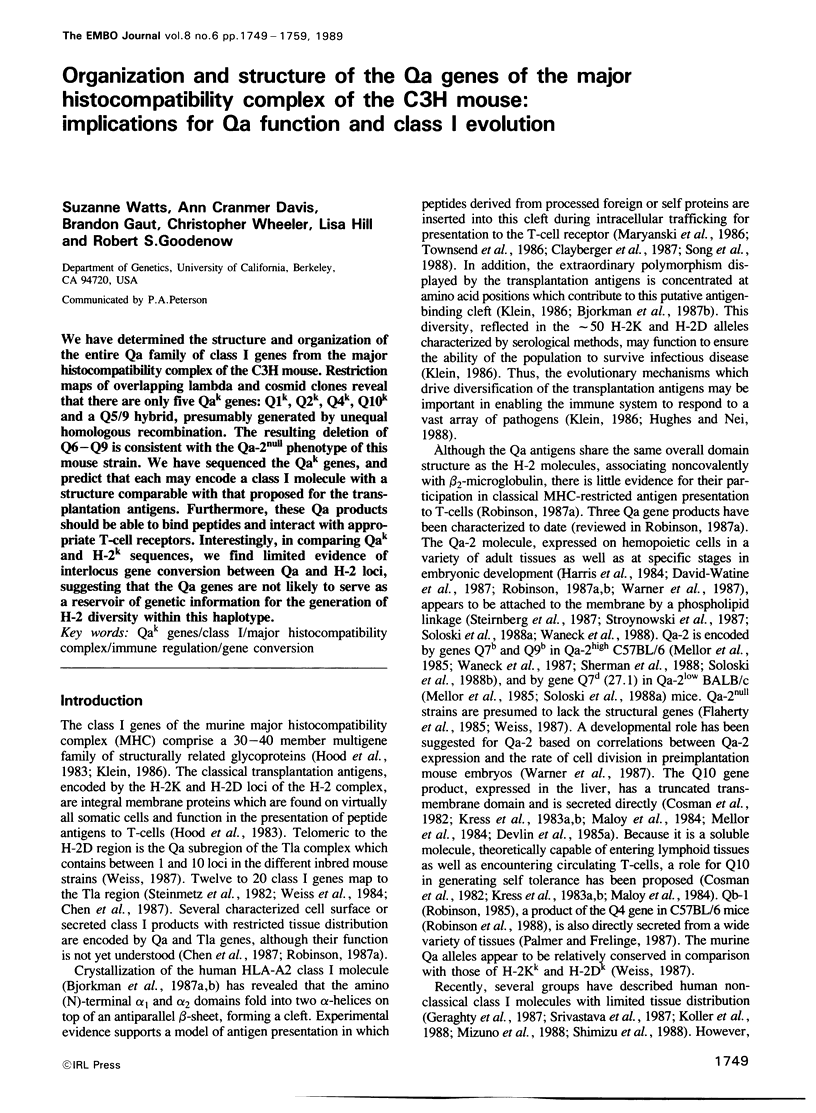




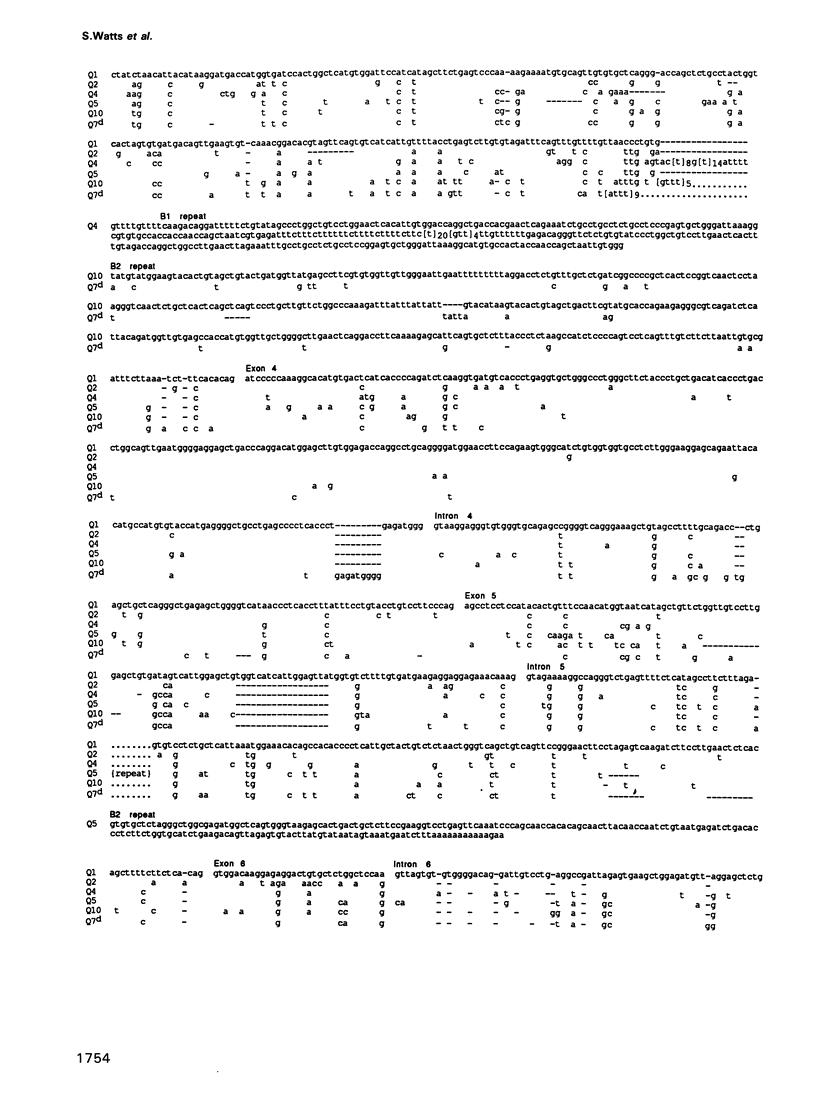
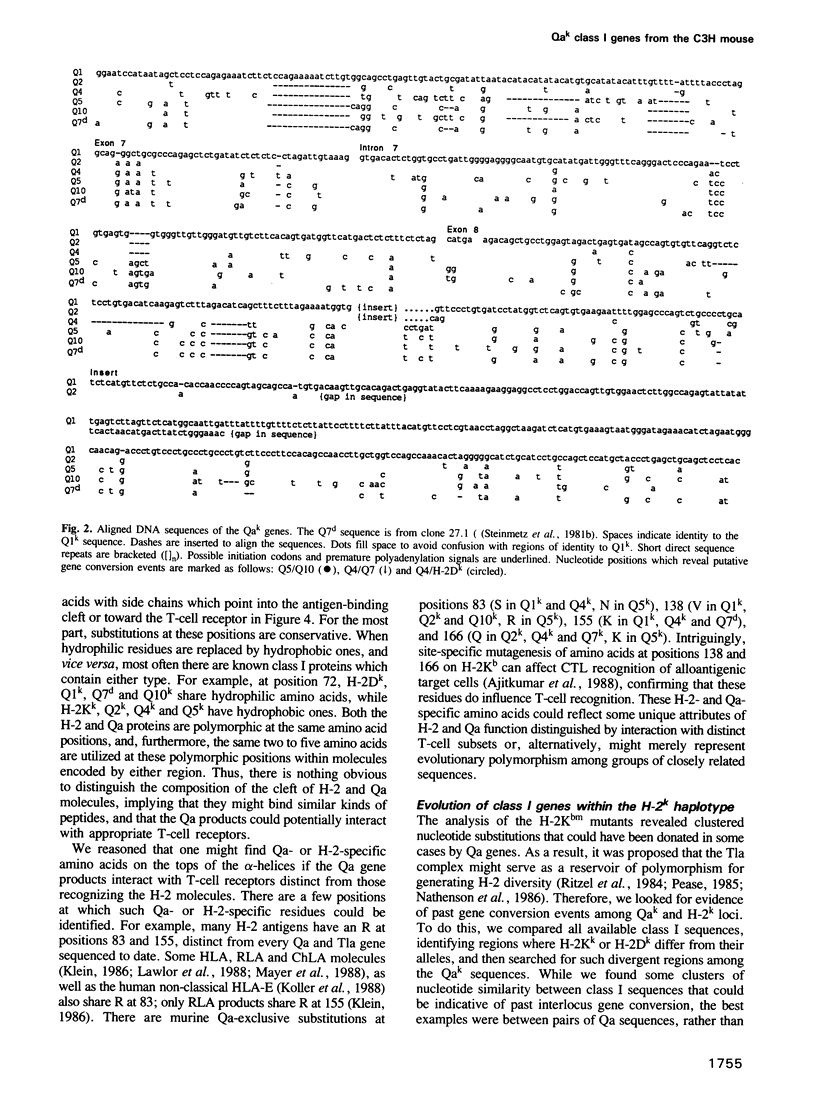
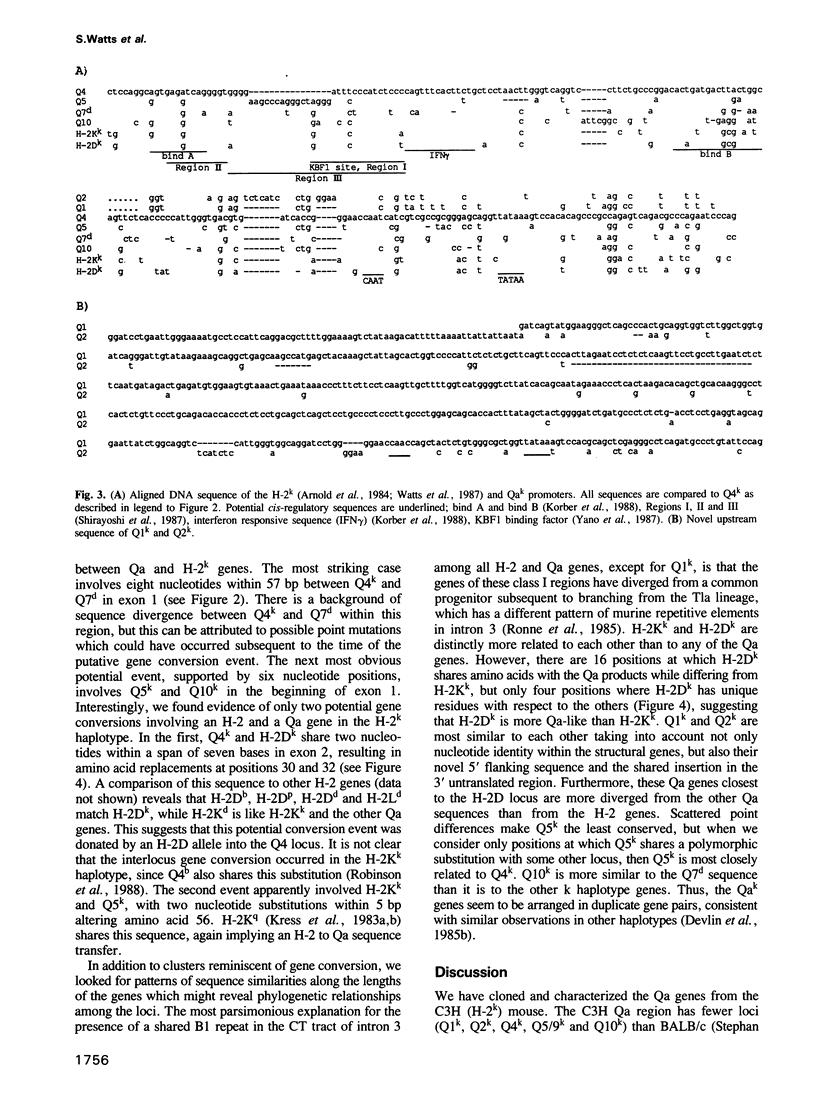
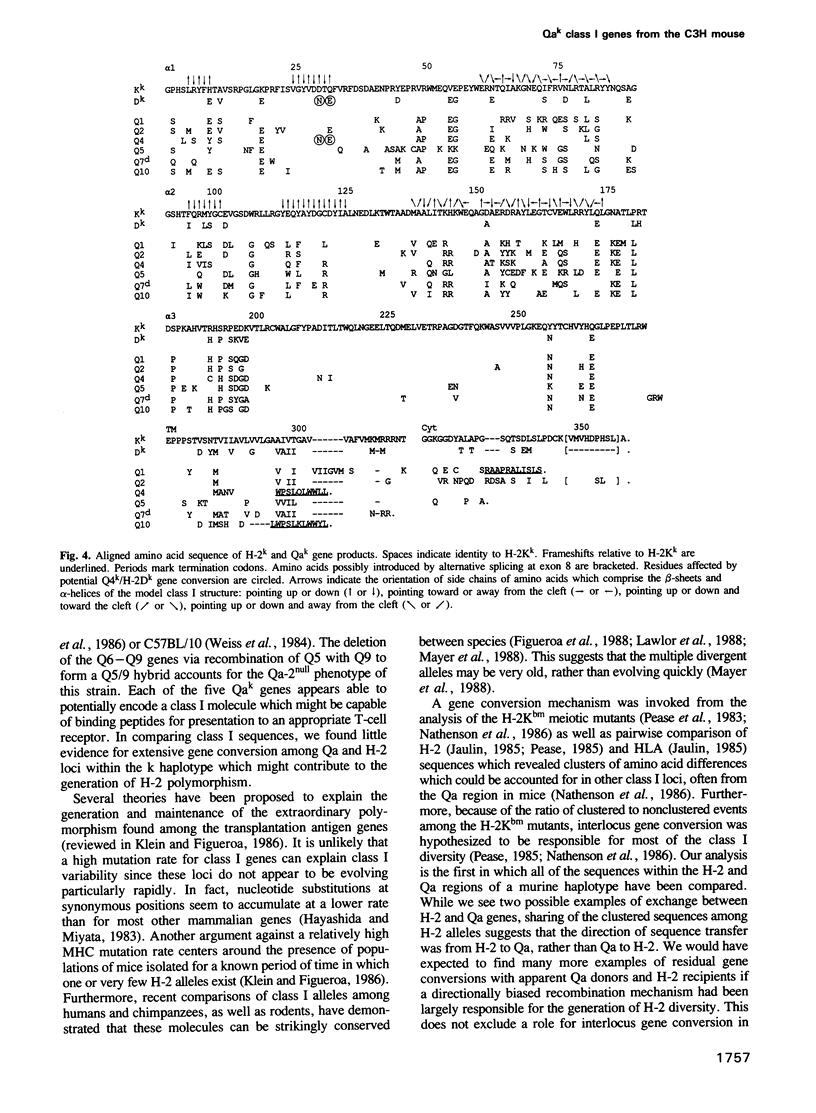


Selected References
These references are in PubMed. This may not be the complete list of references from this article.
- Ajitkumar P., Geier S. S., Kesari K. V., Borriello F., Nakagawa M., Bluestone J. A., Saper M. A., Wiley D. C., Nathenson S. G. Evidence that multiple residues on both the alpha-helices of the class I MHC molecule are simultaneously recognized by the T cell receptor. Cell. 1988 Jul 1;54(1):47–56. doi: 10.1016/0092-8674(88)90178-x. [DOI] [PubMed] [Google Scholar]
- Arnold B., Burgert H. G., Archibald A. L., Kvist S. Complete nucleotide sequence of the murine H-2Kk gene. Comparison of three H-2K locus alleles. Nucleic Acids Res. 1984 Dec 21;12(24):9473–9487. doi: 10.1093/nar/12.24.9473. [DOI] [PMC free article] [PubMed] [Google Scholar]
- Bjorkman P. J., Saper M. A., Samraoui B., Bennett W. S., Strominger J. L., Wiley D. C. Structure of the human class I histocompatibility antigen, HLA-A2. Nature. 1987 Oct 8;329(6139):506–512. doi: 10.1038/329506a0. [DOI] [PubMed] [Google Scholar]
- Bjorkman P. J., Saper M. A., Samraoui B., Bennett W. S., Strominger J. L., Wiley D. C. The foreign antigen binding site and T cell recognition regions of class I histocompatibility antigens. Nature. 1987 Oct 8;329(6139):512–518. doi: 10.1038/329512a0. [DOI] [PubMed] [Google Scholar]
- Chen Y. T., Obata Y., Stockert E., Takahashi T., Old L. J. Tla-region genes and their products. Immunol Res. 1987;6(1-2):30–45. doi: 10.1007/BF02918102. [DOI] [PubMed] [Google Scholar]
- Clayberger C., Parham P., Rothbard J., Ludwig D. S., Schoolnik G. K., Krensky A. M. HLA-A2 peptides can regulate cytolysis by human allogeneic T lymphocytes. Nature. 1987 Dec 24;330(6150):763–765. doi: 10.1038/330763a0. [DOI] [PubMed] [Google Scholar]
- Cosman D., Kress M., Khoury G., Jay G. Tissue-specific expression of an unusual H-2 (class I)-related gene. Proc Natl Acad Sci U S A. 1982 Aug;79(16):4947–4951. doi: 10.1073/pnas.79.16.4947. [DOI] [PMC free article] [PubMed] [Google Scholar]
- David-Watine B., Transy C., Gachelin G., Kourilsky P. Tissue-specific expression of the mouse Q10 H-2 class-I gene during embryogenesis. Gene. 1987;61(2):145–154. doi: 10.1016/0378-1119(87)90109-0. [DOI] [PubMed] [Google Scholar]
- Devlin J. J., Lew A. M., Flavell R. A., Coligan J. E. Secretion of a soluble class I molecule encoded by the Q10 gene of the C57BL/10 mouse. EMBO J. 1985 Feb;4(2):369–374. doi: 10.1002/j.1460-2075.1985.tb03638.x. [DOI] [PMC free article] [PubMed] [Google Scholar]
- Devlin J. J., Weiss E. H., Paulson M., Flavell R. A. Duplicated gene pairs and alleles of class I genes in the Qa2 region of the murine major histocompatibility complex: a comparison. EMBO J. 1985 Dec 1;4(12):3203–3207. doi: 10.1002/j.1460-2075.1985.tb04066.x. [DOI] [PMC free article] [PubMed] [Google Scholar]
- Evans G. A., Wahl G. M. Cosmid vectors for genomic walking and rapid restriction mapping. Methods Enzymol. 1987;152:604–610. doi: 10.1016/0076-6879(87)52068-7. [DOI] [PubMed] [Google Scholar]
- Figueroa F., Günther E., Klein J. MHC polymorphism pre-dating speciation. Nature. 1988 Sep 15;335(6187):265–267. doi: 10.1038/335265a0. [DOI] [PubMed] [Google Scholar]
- Flaherty L., DiBiase K., Lynes M. A., Seidman J. G., Weinberger O., Rinchik E. M. Characterization of a Q subregion gene in the murine major histocompatibility complex. Proc Natl Acad Sci U S A. 1985 Mar;82(5):1503–1507. doi: 10.1073/pnas.82.5.1503. [DOI] [PMC free article] [PubMed] [Google Scholar]
- Forman J., Trial J., Tonkonogy S., Flaherty L. The Qa2 subregion controls the expression of two antigens recognized by H-2-unrestricted cytotoxic T cells. J Exp Med. 1982 Mar 1;155(3):749–767. doi: 10.1084/jem.155.3.749. [DOI] [PMC free article] [PubMed] [Google Scholar]
- Friedman R. L., Stark G. R. alpha-Interferon-induced transcription of HLA and metallothionein genes containing homologous upstream sequences. Nature. 1985 Apr 18;314(6012):637–639. doi: 10.1038/314637a0. [DOI] [PubMed] [Google Scholar]
- Frischauf A. M., Lehrach H., Poustka A., Murray N. Lambda replacement vectors carrying polylinker sequences. J Mol Biol. 1983 Nov 15;170(4):827–842. doi: 10.1016/s0022-2836(83)80190-9. [DOI] [PubMed] [Google Scholar]
- Geraghty D. E., Koller B. H., Orr H. T. A human major histocompatibility complex class I gene that encodes a protein with a shortened cytoplasmic segment. Proc Natl Acad Sci U S A. 1987 Dec;84(24):9145–9149. doi: 10.1073/pnas.84.24.9145. [DOI] [PMC free article] [PubMed] [Google Scholar]
- Harris R. A., Hogarth P. M., Penington D. G., McKenzie I. F. Qa antigens and their differential distribution on lymphoid, myeloid and stem cells. J Immunogenet. 1984 Oct-Dec;11(5-6):265–281. doi: 10.1111/j.1744-313x.1984.tb00814.x. [DOI] [PubMed] [Google Scholar]
- Hayashida H., Miyata T. Unusual evolutionary conservation and frequent DNA segment exchange in class I genes of the major histocompatibility complex. Proc Natl Acad Sci U S A. 1983 May;80(9):2671–2675. doi: 10.1073/pnas.80.9.2671. [DOI] [PMC free article] [PubMed] [Google Scholar]
- Hood L., Steinmetz M., Malissen B. Genes of the major histocompatibility complex of the mouse. Annu Rev Immunol. 1983;1:529–568. doi: 10.1146/annurev.iy.01.040183.002525. [DOI] [PubMed] [Google Scholar]
- Hughes A. L., Nei M. Pattern of nucleotide substitution at major histocompatibility complex class I loci reveals overdominant selection. Nature. 1988 Sep 8;335(6186):167–170. doi: 10.1038/335167a0. [DOI] [PubMed] [Google Scholar]
- Israël A., Kimura A., Kieran M., Yano O., Kanellopoulos J., Le Bail O., Kourilsky P. A common positive trans-acting factor binds to enhancer sequences in the promoters of mouse H-2 and beta 2-microglobulin genes. Proc Natl Acad Sci U S A. 1987 May;84(9):2653–2657. doi: 10.1073/pnas.84.9.2653. [DOI] [PMC free article] [PubMed] [Google Scholar]
- Janeway C. A., Jr, Jones B., Hayday A. Specificity and function of T cells bearing gamma delta receptors. Immunol Today. 1988 Mar;9(3):73–76. doi: 10.1016/0167-5699(88)91267-4. [DOI] [PubMed] [Google Scholar]
- Jaulin C., Perrin A., Abastado J. P., Dumas B., Papamatheakis J., Kourilsky P. Polymorphism in mouse and human class I H-2 and HLA genes is not the result of random independent point mutations. Immunogenetics. 1985;22(5):453–470. doi: 10.1007/BF00418091. [DOI] [PubMed] [Google Scholar]
- Klein J., Figueroa F. Evolution of the major histocompatibility complex. Crit Rev Immunol. 1986;6(4):295–386. [PubMed] [Google Scholar]
- Koller B. H., Geraghty D. E., Shimizu Y., DeMars R., Orr H. T. HLA-E. A novel HLA class I gene expressed in resting T lymphocytes. J Immunol. 1988 Aug 1;141(3):897–904. [PubMed] [Google Scholar]
- Korber B., Mermod N., Hood L., Stroynowski I. Regulation of gene expression by interferons: control of H-2 promoter responses. Science. 1988 Mar 11;239(4845):1302–1306. doi: 10.1126/science.3125612. [DOI] [PubMed] [Google Scholar]
- Kress M., Cosman D., Khoury G., Jay G. Secretion of a transplantation-related antigen. Cell. 1983 Aug;34(1):189–196. doi: 10.1016/0092-8674(83)90149-6. [DOI] [PubMed] [Google Scholar]
- Kress M., Glaros D., Khoury G., Jay G. Alternative RNA splicing in expression of the H-2K gene. Nature. 1983 Dec 8;306(5943):602–604. doi: 10.1038/306602a0. [DOI] [PubMed] [Google Scholar]
- Lalanne J. L., Transy C., Guerin S., Darche S., Meulien P., Kourilsky P. Expression of class I genes in the major histocompatibility complex: identification of eight distinct mRNAs in DBA/2 mouse liver. Cell. 1985 Jun;41(2):469–478. doi: 10.1016/s0092-8674(85)80020-9. [DOI] [PubMed] [Google Scholar]
- Lawlor D. A., Ward F. E., Ennis P. D., Jackson A. P., Parham P. HLA-A and B polymorphisms predate the divergence of humans and chimpanzees. Nature. 1988 Sep 15;335(6187):268–271. doi: 10.1038/335268a0. [DOI] [PubMed] [Google Scholar]
- Lew A. M., Maloy W. L., Coligan J. E. Characteristics of the expression of the murine soluble class I molecule (Q10). J Immunol. 1986 Jan;136(1):254–258. [PubMed] [Google Scholar]
- Linsk R., Vogel J., Stauss H., Forman J., Goodenow R. S. Structure and function of three novel MHC class I antigens derived from a C3H ultraviolet-induced fibrosarcoma. J Exp Med. 1986 Sep 1;164(3):794–813. doi: 10.1084/jem.164.3.794. [DOI] [PMC free article] [PubMed] [Google Scholar]
- Maloy W. L., Coligan J. E., Barra Y., Jay G. Detection of a secreted form of the murine H-2 class I antigen with an antibody against its predicted carboxyl terminus. Proc Natl Acad Sci U S A. 1984 Feb;81(4):1216–1220. doi: 10.1073/pnas.81.4.1216. [DOI] [PMC free article] [PubMed] [Google Scholar]
- Mann D. W., Stroynowski I., Hood L., Forman J. Cytotoxic T lymphocytes from mice with soluble class I Q10 molecules in their serum are not tolerant to membrane-bound Q10. J Immunol. 1987 Jan 1;138(1):240–245. [PubMed] [Google Scholar]
- Mann D., Forman J. Recognition by cytotoxic T lymphocytes of Qa-2 antigens. Sensitivity of Qa-2 molecules to phosphatidylinositol-specific phospholipase C. J Immunol. 1988 Sep 15;141(6):1813–1818. [PubMed] [Google Scholar]
- Maryanski J. L., Pala P., Corradin G., Jordan B. R., Cerottini J. C. H-2-restricted cytolytic T cells specific for HLA can recognize a synthetic HLA peptide. Nature. 1986 Dec 11;324(6097):578–579. doi: 10.1038/324578a0. [DOI] [PubMed] [Google Scholar]
- Mayer W. E., Jonker M., Klein D., Ivanyi P., van Seventer G., Klein J. Nucleotide sequences of chimpanzee MHC class I alleles: evidence for trans-species mode of evolution. EMBO J. 1988 Sep;7(9):2765–2774. doi: 10.1002/j.1460-2075.1988.tb03131.x. [DOI] [PMC free article] [PubMed] [Google Scholar]
- Mellor A. L., Antoniou J., Robinson P. J. Structure and expression of genes encoding murine Qa-2 class I antigens. Proc Natl Acad Sci U S A. 1985 Sep;82(17):5920–5924. doi: 10.1073/pnas.82.17.5920. [DOI] [PMC free article] [PubMed] [Google Scholar]
- Mellor A. L., Weiss E. H., Kress M., Jay G., Flavell R. A. A nonpolymorphic class I gene in the murine major histocompatibility complex. Cell. 1984 Jan;36(1):139–144. doi: 10.1016/0092-8674(84)90082-5. [DOI] [PubMed] [Google Scholar]
- Mizuno S., Trapani J. A., Koller B. H., Dupont B., Yang S. Y. Isolation and nucleotide sequence of a cDNA clone encoding a novel HLA class I gene. J Immunol. 1988 Jun 1;140(11):4024–4030. [PubMed] [Google Scholar]
- Nathenson S. G., Geliebter J., Pfaffenbach G. M., Zeff R. A. Murine major histocompatibility complex class-I mutants: molecular analysis and structure-function implications. Annu Rev Immunol. 1986;4:471–502. doi: 10.1146/annurev.iy.04.040186.002351. [DOI] [PubMed] [Google Scholar]
- O'Neill A. E., Reid K., Garberi J. C., Karl M., Flaherty L. Extensive deletions in the Q region of the mouse major histocompatibility complex. Immunogenetics. 1986;24(6):368–373. doi: 10.1007/BF00377954. [DOI] [PubMed] [Google Scholar]
- Palmer M. J., Frelinger J. A. Widespread transcription of a Qa region gene in adult mice. J Exp Med. 1987 Jul 1;166(1):95–108. doi: 10.1084/jem.166.1.95. [DOI] [PMC free article] [PubMed] [Google Scholar]
- Pease L. R. Diversity in H-2 genes encoding antigen-presenting molecules is generated by interactions between members of the major histocompatibility complex gene family. Transplantation. 1985 Mar;39(3):227–231. doi: 10.1097/00007890-198503000-00001. [DOI] [PubMed] [Google Scholar]
- Pease L. R., Schulze D. H., Pfaffenbach G. M., Nathenson S. G. Spontaneous H-2 mutants provide evidence that a copy mechanism analogous to gene conversion generates polymorphism in the major histocompatibility complex. Proc Natl Acad Sci U S A. 1983 Jan;80(1):242–246. doi: 10.1073/pnas.80.1.242. [DOI] [PMC free article] [PubMed] [Google Scholar]
- Robinson P. J., Bevec D., Mellor A. L., Weiss E. H. Sequence of the mouse Q4 class I gene and characterization of the gene product. Immunogenetics. 1988;27(2):79–86. doi: 10.1007/BF00351079. [DOI] [PubMed] [Google Scholar]
- Robinson P. J. Qb-1, a new class I polypeptide encoded by the Qa region of the mouse H-2 complex. Immunogenetics. 1985;22(3):285–289. doi: 10.1007/BF00404488. [DOI] [PubMed] [Google Scholar]
- Robinson P. J. Structure and expression of polypeptides encoded in the mouse Qa region. Immunol Res. 1987;6(1-2):46–56. doi: 10.1007/BF02918103. [DOI] [PubMed] [Google Scholar]
- Robinson P. J. Two different biosynthetic pathways for the secretion of Qa region-associated class I antigens by mouse lymphocytes. Proc Natl Acad Sci U S A. 1987 Jan;84(2):527–531. doi: 10.1073/pnas.84.2.527. [DOI] [PMC free article] [PubMed] [Google Scholar]
- Ronne H., Widmark E., Rask L., Peterson P. A. Intron sequences reveal evolutionary relationships among major histocompatibility complex class I genes. Proc Natl Acad Sci U S A. 1985 Sep;82(17):5860–5864. doi: 10.1073/pnas.82.17.5860. [DOI] [PMC free article] [PubMed] [Google Scholar]
- Sherman D. H., Waneck G. L., Flavell R. A. Qa-2 antigen encoded by Q7b is biochemically indistinguishable from Qa-2 expressed on the surface of C57BL/10 mouse spleen cells. J Immunol. 1988 Jan 1;140(1):138–142. [PubMed] [Google Scholar]
- Shimizu Y., Geraghty D. E., Koller B. H., Orr H. T., DeMars R. Transfer and expression of three cloned human non-HLA-A,B,C class I major histocompatibility complex genes in mutant lymphoblastoid cells. Proc Natl Acad Sci U S A. 1988 Jan;85(1):227–231. doi: 10.1073/pnas.85.1.227. [DOI] [PMC free article] [PubMed] [Google Scholar]
- Shirayoshi Y., Miyazaki J., Burke P. A., Hamada K., Appella E., Ozato K. Binding of multiple nuclear factors to the 5' upstream regulatory element of the murine major histocompatibility class I gene. Mol Cell Biol. 1987 Dec;7(12):4542–4548. doi: 10.1128/mcb.7.12.4542. [DOI] [PMC free article] [PubMed] [Google Scholar]
- Singer M. F. Highly repeated sequences in mammalian genomes. Int Rev Cytol. 1982;76:67–112. doi: 10.1016/s0074-7696(08)61789-1. [DOI] [PubMed] [Google Scholar]
- Soloski M. J., Hood L., Stroynowski I. Qa-region class I gene expression: identification of a second class I gene, Q9, encoding a Qa-2 polypeptide. Proc Natl Acad Sci U S A. 1988 May;85(9):3100–3104. doi: 10.1073/pnas.85.9.3100. [DOI] [PMC free article] [PubMed] [Google Scholar]
- Soloski M. J., Lattimore A., Hereld D., Krakow J. L., Low M. G., Einhorn G. Further characterization of the membrane anchor found on the tissue-specific class I molecule Qa2. J Immunol. 1988 Jun 1;140(11):3858–3866. [PubMed] [Google Scholar]
- Soloski M. J., Vernachio J., Einhorn G., Lattimore A. Qa gene expression: biosynthesis and secretion of Qa-2 molecules in activated T cells. Proc Natl Acad Sci U S A. 1986 May;83(9):2949–2953. doi: 10.1073/pnas.83.9.2949. [DOI] [PMC free article] [PubMed] [Google Scholar]
- Song E. S., Linsk R., Olson C. A., McMillan M., Goodenow R. S. Allospecific cytotoxic T lymphocytes recognize an H-2 peptide in the context of a murine major histocompatibility complex class I molecule. Proc Natl Acad Sci U S A. 1988 Mar;85(6):1927–1931. doi: 10.1073/pnas.85.6.1927. [DOI] [PMC free article] [PubMed] [Google Scholar]
- Srivastava R., Chorney M. J., Lawrance S. K., Pan J., Smith Z., Smith C. L., Weissman S. M. Structure, expression, and molecular mapping of a divergent member of the class I HLA gene family. Proc Natl Acad Sci U S A. 1987 Jun;84(12):4224–4228. doi: 10.1073/pnas.84.12.4224. [DOI] [PMC free article] [PubMed] [Google Scholar]
- Steinmetz M., Frelinger J. G., Fisher D., Hunkapiller T., Pereira D., Weissman S. M., Uehara H., Nathenson S., Hood L. Three cDNA clones encoding mouse transplantation antigens: homology to immunoglobulin genes. Cell. 1981 Apr;24(1):125–134. doi: 10.1016/0092-8674(81)90508-0. [DOI] [PubMed] [Google Scholar]
- Steinmetz M., Moore K. W., Frelinger J. G., Sher B. T., Shen F. W., Boyse E. A., Hood L. A pseudogene homologous to mouse transplantation antigens: transplantation antigens are encoded by eight exons that correlate with protein domains. Cell. 1981 Sep;25(3):683–692. doi: 10.1016/0092-8674(81)90175-6. [DOI] [PubMed] [Google Scholar]
- Steinmetz M., Winoto A., Minard K., Hood L. Clusters of genes encoding mouse transplantation antigens. Cell. 1982 Mar;28(3):489–498. doi: 10.1016/0092-8674(82)90203-3. [DOI] [PubMed] [Google Scholar]
- Stephan D., Sun H., Lindahl K. F., Meyer E., Hämmerling G., Hood L., Steinmetz M. Organization and evolution of D region class I genes in the mouse major histocompatibility complex. J Exp Med. 1986 May 1;163(5):1227–1244. doi: 10.1084/jem.163.5.1227. [DOI] [PMC free article] [PubMed] [Google Scholar]
- Stiernberg J., Low M. G., Flaherty L., Kincade P. W. Removal of lymphocyte surface molecules with phosphatidylinositol-specific phospholipase C: effects on mitogen responses and evidence that ThB and certain Qa antigens are membrane-anchored via phosphatidylinositol. J Immunol. 1987 Jun 1;138(11):3877–3884. [PubMed] [Google Scholar]
- Stroynowski I., Soloski M., Low M. G., Hood L. A single gene encodes soluble and membrane-bound forms of the major histocompatibility Qa-2 antigen: anchoring of the product by a phospholipid tail. Cell. 1987 Aug 28;50(5):759–768. doi: 10.1016/0092-8674(87)90334-5. [DOI] [PubMed] [Google Scholar]
- Sugita K., Miyazaki J., Appella E., Ozato K. Interferons increase transcription of a major histocompatibility class I gene via a 5' interferon consensus sequence. Mol Cell Biol. 1987 Jul;7(7):2625–2630. doi: 10.1128/mcb.7.7.2625. [DOI] [PMC free article] [PubMed] [Google Scholar]
- Townsend A. R., Rothbard J., Gotch F. M., Bahadur G., Wraith D., McMichael A. J. The epitopes of influenza nucleoprotein recognized by cytotoxic T lymphocytes can be defined with short synthetic peptides. Cell. 1986 Mar 28;44(6):959–968. doi: 10.1016/0092-8674(86)90019-x. [DOI] [PubMed] [Google Scholar]
- Vogel J. M., Davis A. C., McKinney D. M., McMillan M., Martin W. J., Goodenow R. S. Molecular characterization of the C3HfB/HeN H-2Kkm2 mutation. Implications for the molecular basis of alloreactivity. J Exp Med. 1988 Nov 1;168(5):1781–1800. doi: 10.1084/jem.168.5.1781. [DOI] [PMC free article] [PubMed] [Google Scholar]
- Vogel J., Kress M., Khoury G., Jay G. A transcriptional enhancer and an interferon-responsive sequence in major histocompatibility complex class I genes. Mol Cell Biol. 1986 Oct;6(10):3550–3554. doi: 10.1128/mcb.6.10.3550. [DOI] [PMC free article] [PubMed] [Google Scholar]
- Waneck G. L., Sherman D. H., Calvin S., Allen H., Flavell R. A. Tissue-specific expression of cell-surface Qa-2 antigen from a transfected Q7b gene of C57BL/10 mice. J Exp Med. 1987 May 1;165(5):1358–1370. doi: 10.1084/jem.165.5.1358. [DOI] [PMC free article] [PubMed] [Google Scholar]
- Waneck G. L., Sherman D. H., Kincade P. W., Low M. G., Flavell R. A. Molecular mapping of signals in the Qa-2 antigen required for attachment of the phosphatidylinositol membrane anchor. Proc Natl Acad Sci U S A. 1988 Jan;85(2):577–581. doi: 10.1073/pnas.85.2.577. [DOI] [PMC free article] [PubMed] [Google Scholar]
- Warner C. M., Gollnick S. O., Flaherty L., Goldbard S. B. Analysis of Qa-2 antigen expression by preimplantation mouse embryos: possible relationship to the preimplantation-embryo-development (Ped) gene product. Biol Reprod. 1987 Apr;36(3):611–616. doi: 10.1095/biolreprod36.3.611. [DOI] [PubMed] [Google Scholar]
- Watts S., Vogel J. M., Harriman W. D., Itoh T., Stauss H. J., Goodenow R. S. DNA sequence analysis of the C3H H-2Kk and H-2Dk loci. Evolutionary relationships to H-2 genes from four other mouse strains. J Immunol. 1987 Dec 1;139(11):3878–3885. [PubMed] [Google Scholar]
- Weiss E. H., Golden L., Fahrner K., Mellor A. L., Devlin J. J., Bullman H., Tiddens H., Bud H., Flavell R. A. Organization and evolution of the class I gene family in the major histocompatibility complex of the C57BL/10 mouse. Nature. 1984 Aug 23;310(5979):650–655. doi: 10.1038/310650a0. [DOI] [PubMed] [Google Scholar]
- Weiss E. H. Molecular biology of the mouse Q region. Immunol Res. 1987;6(3):179–191. doi: 10.1007/BF02918090. [DOI] [PubMed] [Google Scholar]
- Yano O., Kanellopoulos J., Kieran M., Le Bail O., Israël A., Kourilsky P. Purification of KBF1, a common factor binding to both H-2 and beta 2-microglobulin enhancers. EMBO J. 1987 Nov;6(11):3317–3324. doi: 10.1002/j.1460-2075.1987.tb02652.x. [DOI] [PMC free article] [PubMed] [Google Scholar]


